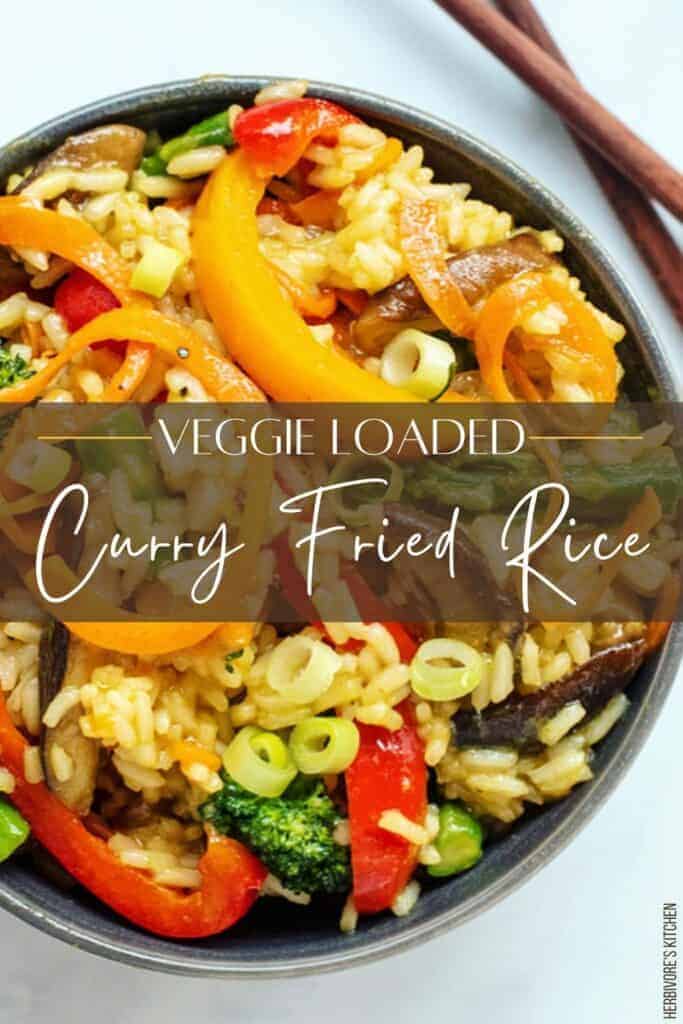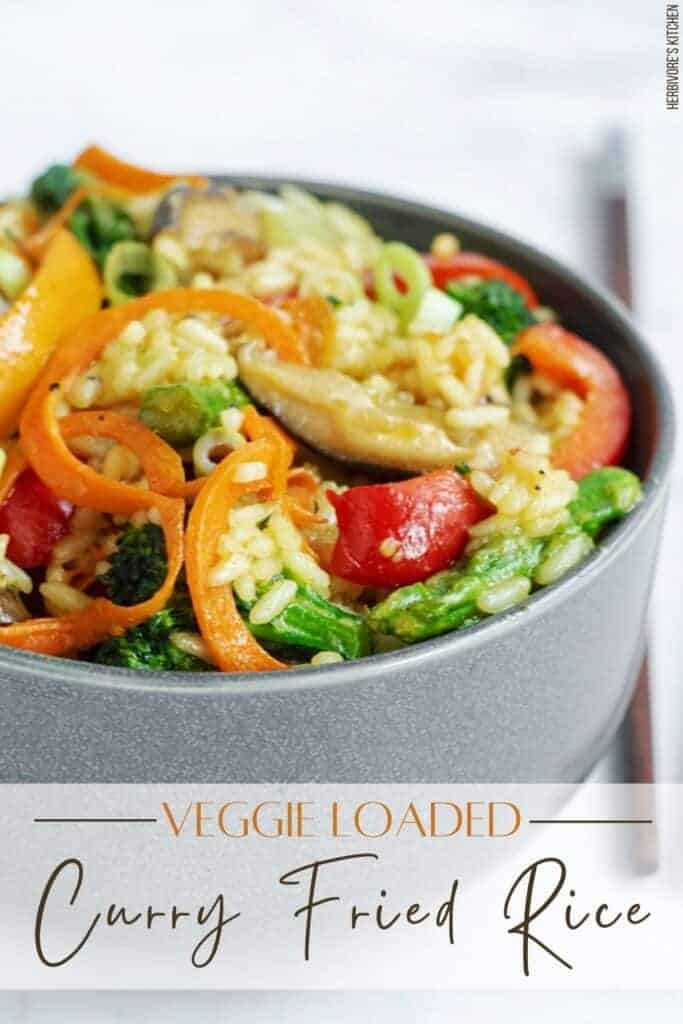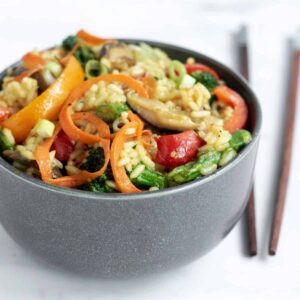This Veggie-Loaded Curry Fried Rice Recipe includes affiliate links. When I find a great product or service, I like to share it with my readers. Sometimes I use affiliate links so I can earn commission for my recommendations. Thank you for your support!
Veggie-Loaded Curry Fried Rice
Looking to satisfy a craving for takeout without picking up the phone? This curry fried rice is a quick and easy way to put a vegan meal on the table. Packed with fresh vegetables, this plant-based fried rice recipe checks every box. Fragrant jasmine rice soaks up the yellow curry spiced sauce as it crisps in a hot wok while tamari, pepper and sriracha provide for for a warm, slightly spicy and highly fragrant dish. It’s vegan comfort food at its finest!

How to Solve for a Fried Rice Craving at Home
Several years ago when my kids were little and my husband traveled a lot for work, my favorite thing to do was to put my kids to bed and then order takeout. I liked to indulge in it in sweatpants, while having full control over the remote control, along with a glass of wine. What can I say, some people use time alone to clean out a closet or read a book; I liked eating stir-fried Singapore noodles. And fried spring rolls. And fried rice.
Takeout is something that I think about a little differently these days though. Don’t get me wrong, I have very fond memories of those evenings described above. And, alas, takeout cravings do still strike and… sometimes… I just satisfy them. As I discuss in my About Me page, I am not the perfect vegan. But I’ve come a long way baby. In fact, just the other night my husband had a late meeting and every fiber in my being called for takeout. Then, as I did when I created my Roasted Cauliflower in a Sticky Lemon Sauce, my Vegetable Lo Mein and my Asian BBQ Tofu Bowls, I instead decided to come up with a recipe to conquer my love of Singapore noodles and fried rice — all in one dish.
How to Make (Singapore) Curry Fried Rice
f you haven’t had them before, Singapore noodles are the ultimate in comfort food. This dish features thin rice noodles (called vermicelli noodles). They’re pre-soaked and then stir-fried in a curry sauce. Traditional Singapore noodles often include pork, eggs and limited vegetables, like green onions and red bell pepper. Fried rice is similar, although it’s not usually made using a curry sauce. Like Singapore noodles, fried rice is stir fried and usually includes pork and eggs. Vegetables traditionally include small-diced red peppers, carrots and green peas.
For this fusion dish, I decided to combine these two dishes by swapping the vermicelli noodles for jasmine rice. I kept the curry sauce, which is warm with hints of spice and salt. Then, to make this dish vegan, I replaced oyster sauce and/or fish sauce (two common ingredients in Singapore noodles and fried rice) by increasing the tamari sauce in the dish. If you’re feeling ambitious though, vegan fish sauce is available in some markets or you can make it yourself using my Vegan Fish Sauce recipe. If you decide to go this route, cut the amount of tamari in half and replace it with vegan fish sauce.

While the rice is crispy and the sauce is flavorful, the best part of this vegan fried rice is that it’s loaded with a ton of fresh vegetables. Stir-shiitake mushrooms give it a rich, meaty feel. Sliced red and orange peppers, spiralized carrots, broccolini and asparagus brighten it up and pack it full of healthy nutrients. The cooking is timed so that the vegetables stay vibrant and crispy, making it a fully satisfying vegan dish.
What Rice is Best for Fried Rice
If you’re new to cooking, you might not know that all rice is not created equal. Different rice types are work better in different dishes. As a basic primer, you should know that rice comes in both short and long grains. Short grain rices, like Arborio and Bomba rice, are highly absorbent and become soft and sticky when cooked. They are great candidates for dishes like Vegan Paella and vegan sushi. By contrast, long-grain rice varieties, like Basmati and Jasmine rice, stay dry and separate when cooked. These types of rice are good choices for dishes like Thai Red Curry and this Curry Fried Rice.
How to Prepare Rice for a Fried Rice Recipe
I picked up this tip from Gimme Some Oven’s Fried Rice recipe — warm rice does not make for good fried rice. I’ll admit, I had to fly in the face of this advice several times before I heeded it. Now I can attest: it does make a difference.
The best way to make sure that you’re rice ready for fried rice is to make it a day in advance and store it in the refrigerator. But, if a craving strikes you can still have your fried rice the same day. You can cool the rice simply by spreading it out on a baking sheet and putting it in the refrigerator until the temperature comes down. This takes about 30 minutes if you occasionally turn the rice over with a spoon while it’s chilling.
- Choose a Wok. I know. Kitchen gadgets. Do you really need them all? But, to that I say: if you’re going to kick that takeout habit you’re going to need to invest in a good wok. Woks have a few major advantages over a traditional frying pan, but they all have a central theme. Woks have great working space.
- Don’t Crowd Your Wok. A crowded wok leads to steam and steam equals mush. If crispy fried rice is your goal use all of the real estate that a wok has to offer and fry the rice in stages simply by pushing the other ingredients aside. You’ll see how I do this in the recipe directions below.
- Get That Wok HOT! A hot wok is necessary for frying the rice. I also like to give the rice some time to stay in contact with the bottom of the wok, so I don’t stir it constantly but rather let it sit undisturbed for short periods of time. You’ll see I worked this tip into the recipe directions below as well.
Curry Fried Rice — Yet Another Way to Enjoy Curry!
Several weeks ago, I posted the article What is Curry? on my blog. Curries are a wonderful way to put a vegan-friendly dinner on the table. They’re rich and flavorful and easy to make. But what are they exactly?

As I discuss in that blog post, curries are (very generically) a rice dish in a flavored sauce. There are Indian curries, Thai curries, Japanese curries, wet curries and dry curries. They can be mild, medium and hot. All curries though, are wonderfully tasty and this Curry Fried Rice is no exception.
Like Singapore noodles, the sauce for this Curry Fried Rice features yellow curry powder. Yellow curry is an Indian curry. It’s more mild in flavor than other curries, featuring cumin, coriander, turmeric, ginger and garlic, cinnamon and cardamom. When shopping for this recipe, look for a mild curry powder in the spice aisle or pick up a specialty blend from one of my favorite vendors SavorySpiceShop.com.
What is Shaoxing Wine?
I wanted to include a quick note on this ingredient since it’s likely to be new to a lot of home cooks. Shaoxing wine is Chinese cooking wine made from fermented rice. Shaoxing wine should not be confused with sake (a dry Japanese rice wine) or mirin (a sweet Japanese rice wine) as they have different flavors. You should also be careful to distinguish it from rice wine vinegar, which is a different product as well. If you’re looking for a Shaoxing wine substitute, you can use dry cooking sherry in its stead.
What’s in My Kitchen to Make This Veggie-Loaded Curry Fried Rice Recipe Easier?
Want to know what tools and resources I keep on hand to make my vegan cooking even easier? Here’s a short list of what helped me create this blog post and recipe. For the complete list, visit my Shop where you can find the kitchen gadgets I like as well as a list of books that I recommend.
Reusable, Upcycled Napkins
Before I get into cooking, I want to share these napkins. I found these on Etsy over a year ago and, not only do I LOVE them, I buy them as gifts for nearly everyone I know.
These napkins are upcycled and reusable, allowing you to not only avoid throwing away paper products but to also reuse fabrics – a small but significant way to cut back on water, dyes and chemicals used in the production process.
These napkins are so darling (they come in lots of different patterns and colors) and they’re machine washable. I just throw them in with whatever load of laundry I’m doing. They don’t wrinkle easily, so a quick fold will have them back on your table doing what they were meant to do… be reused!
Electric Wok
While I do try to limit the number of kitchen gadgets I have, my electric wok makes the cut. Why cook with a wok? Well, for starters, there is plenty of room to toss! They also heat up quickly and evenly, enabling a nice sear on ingredients.
Spiralizer
Vegetables never had it so good!
I’m telling you, vegetables just taste better when you cut them into fun shapes. Okay-that’s only partially true. What totally true is that you can spiralize zucchini and replace your pasta for a veggie-forward “pasta” dinner (and make it even better by topping it with my Homemade Garden Vegetable Tomato Sauce). Not into zucchini? How about those crispy sweet potato chips topping my Veggie-Loaded Easy Vegan Ramen Soup? Who doesn’t love chips!
A Really, Really Good Chef’s Knife
No, that’s not the brand. It’s just the idea! But, I own this set of Global™ knives and They’re some of my most prized possessions in the kitchen. This set is universally well-rated for the at-home chef and will get you a good, solid set of knives without totally breaking the bank.
Garlic Peeler
I only bought one of these a few months ago, but wow! I’m so much happier not peeling garlic cloves with my fingernails. I’m pretty sure I’ll collectively get at least a day of my life back because of this device.
Garlic Press
I’ve read a dozen posts about why you shouldn’t use a garlic press. One of them actually suggested that they take up valuable kitchen space. I mean, I guess if you have a tiny kitchen you might have to make those choices. They’re smaller than a can opener. I love mine. I hate, hate, hate mincing garlic.
Chopsticks
Here’s my theory: food tastes better if it’s eaten with the utensils it was designed for. This is why I use Ramen Soup Spoons for my ramen bowls (check out my Veggie Loaded Veggie Ramen) and why I use chopsticks for dishes like my Vegetable Lo Mein.
These fiberglass chopsticks are attractive, inexpensive and reusable and won’t give you splinters!
Veggie Loaded Curry Fried Rice
Ingredients
- 2 cups dry Jasmine rice
- 1/4 cup low-sodium tamari
- 1/4 cup Shaoxing wine Chinese rice wine (for more details, please read my blog post)
- 1 tbsp yellow curry powder or look for mild Indian curry powder
- 1 tbsp white sugar
- 1/2 tsp white pepper or substitute with ground black pepper
- 12-15 shiitake mushrooms washed, destemmed and sliced
- 1 bunch asparagus washed, trimmed and sliced into bite-sized pieces
- 1 bunch broccolini washed, trimmed and cut into bite-sized pieces
- 1/4 cup water
- 1 scallion washed, trimmed and thinly sliced with the white parts separated from the green parts
- 4 tbsp safflower oil divided
- 1 tbsp fresh garlic minced
- 1 carrot washed and spiralized or cut into bite-sized pieces
- 1/2 red bell pepper washed, deseeded and cut into slices
- 1/2 orange bell pepper washed, deseeded and cut into slices
- salt & pepper to taste
- extra tamari sprinkled over finished dish, to taste
- sriracha sauce for spice, to taste
Instructions
- Prepare the jasmine rice in accordance with the package directions. When the rice is fully cooked, thinly spread it on a baking sheet and allow it to chill in the refrigerator for 30 minutes or until completely cooled. See my blog post for details.
- Combine the tamari, Shaoxing wine, yellow curry powder, sugar and pepper in a small mixing bowl. Set aside.
- Heat your wok and add the mushrooms, asparagus and broccolini with 1/4 cup of water. Simmer the vegetables until the water has cooked off. Remove the vegetables from the wok.
- Reduce the heat to medium-low and add 2 tbsp of safflower oil, the scallion whites and the garlic to the wok. Sauté until fragrant, being careful not to burn.
- Increase the temperature of the wok to high. When hot add the mushrooms, asparagus, broccolini, peppers and carrots to the wok. Stir fry the veggies in the oil. About 2-3 minutes. You want the vegetables to remain crisp and brightly colored.
- Push the stir fried vegetables to the side of the wok and add the remaining 2 tbsp of safflower oil and the chilled rice. Stir the rice to coat it in the oil. Keeping the wok temperature high, allow the rice to sit undisturbed for 30 seconds before stirring again. Do this 3-4 times so that the rice on the bottom of the wok rotates to develop a slightly crisped texture.
- Stir the vegetables into the rice and then add the curry sauce. Stir the sauce into the rice and vegetables until they are thoroughly coated and the finished dish is hot.
- Serve immediately garnished with scallion greens, salt & pepper, tamari and sriracha, as desired.
About Herbivore’s Kitchen

Herbivore’s Kitchen is a blog run by me, a plant-based home chef and aspiring food photographer. I switched my and my family’s diet to a plant-based diet after learning about the health benefits of going vegan. Making this change has prompted a variety of food and holistic-lifestyle related questions that I explore through this blog. I talk about how to pick and prepare the most nutritious foods, to how to reduce waste at home, to how to live a more sustainable lifestyle while on the road.








